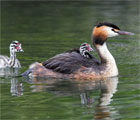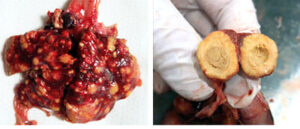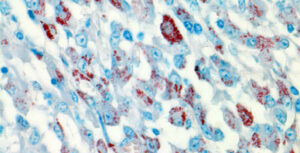Avian tuberculosis in a great crested grebe (Podiceps cristatus)

Podiceps cristatus, volwassene met kuikens.
(Photo, M. Mollet, Saxifraga)
In June 2011 an adult male great crested grebe (Podiceps cristatus) found in the Dutch coastal town of Muidenberg, was submitted to the DWHC for post-mortem investigation.
Macroscopic findings
The bird had a moderately good nutritional status with reasonable fat reserves and poorly developed musculature. The gastrointestinal tract contained green pasty material, indicating that it had eaten shortly before its death.
Large numbers of well-circumscribed firm yellow nodules of 1-3x7mm were found in the lungs (photo 2), liver, intestines and gizzard and the spleen was almost completely replaced by this material (photo 3).
 |
| Photo 2 (links): Longen van de fuut ; Photo 3 (rechts): milt van de fuut Photos: L. Begeman, DWHC |
Microscopic findings
An impression smear from these lesions showed large numbers of macrophages characteristic of a granulomatous inflammation; these cells contained “ghost” (non-staining) bacteria.
Examination of the tissues under the microscope revealed granulomas in multiple organs and the muscles. The ghost bacteria in the macrophages were stained using special techniques (Ziehl-Neelsen) to demonstrate acid-fast organisms (photo 4), consistent with Mycobacteria.
 |
Impression smear of the acid-fast or ‘ghost’ bacteria seen in macrophages in the lesions. Mycobacteria are not the only acid-fast bacteria; others include Nocardia, some bacterial spores, and some coccidia. Whilst highly suggestive of mycobacterial infection, this can only be confirmed with culture or molecular techniques. |
| Photo 4 |
Laboratory tests
Mycobacterium avium complex was confirmed by bacterial culture carried out at the Central Veterinary Institute of Wageningen UR.
Conclusion
The great crested grebe appear to have died from advanced, systemic avian tuberculosis.



